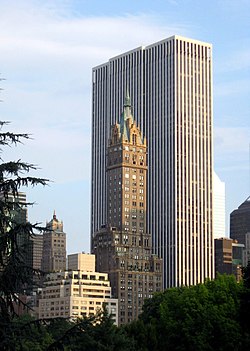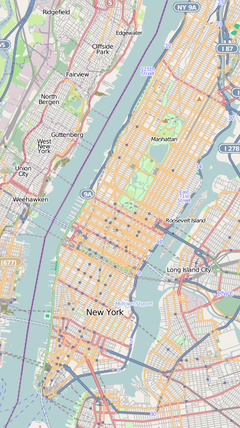General Motors Building (New York)
| General Motors Building | |
|---|---|

The building as seen from Central Park in 2008
|
|
|
Location within Manhattan
|
|
| General information | |
| Status | Complete |
| Type | Offices, retail |
| Architectural style | International Style |
| Location | 767 5th Ave, New York City, NY 10153, USA |
| Coordinates | 40°45′50″N 73°58′21″W / 40.76389°N 73.97250°WCoordinates: 40°45′50″N 73°58′21″W / 40.76389°N 73.97250°W |
| Construction started | 1964 |
| Completed | 1968 |
| Owner | Boston Properties |
| Height | |
| Roof | 705 ft (215 m) |
| Technical details | |
| Floor count | 50 |
| Floor area | 1,637,363 sq ft (152,116.0 m2) |
| Design and construction | |
| Architect |
Edward Durell Stone & Associates Emery Roth & Sons |
| Developer | Cecilia Benattar |
| Engineer | The Office of James Ruderman |
The General Motors Building is a 50-story, 705 ft (215 m) office tower at 767 Fifth Avenue in Manhattan, New York City. The building, which is bound by Fifth Avenue and Madison Avenue between 59th Street and 58th Street, is one of the few structures in Manhattan to occupy a full city block. With 1,774,000 net leasable square feet, the tower sits on the site of the former Savoy-Plaza Hotel and affords views of Central Park. It was designed in the international style by Edward Durell Stone & Associates with Emery Roth & Sons and completed in 1968.
Currently owned by a joint venture of Boston Properties, Zhang Xin, and the Safra banking family, the GM Building remains one of New York's most recognized and expensive office properties. Rents typically exceed $100 per square foot; a 2013 transaction among minority owners valued the building around $3.4 billion.
The building was built and developed by Cecilia Benattar, President and Chief Executive Officer of the North American holdings of the vast British holding company London Merchant Securities PLC.
Its design was completed the same year the 1964 New York World's Fair opened. Construction began after demolition of the Savoy-Plaza in 1965, and was completed in 1968. The façade is an expression of unbroken verticality in "glistening white Georgia marble" and sheets of glass. Both architectural firms were prolific skyscraper designers contributing to much of Manhattan's urban fabric; however, the property has been more attractive as a piece of real estate and as a home to its corporate tenants than it has to architecture critics. Paul Goldberger and Ada Louise Huxtable both wrote negative critical reviews of the building and even the first edition of the AIA Guide to New York City (1968), an unabashed apology for International Modernism, noted, "The hue and cry over the new behemoth was based, not on architecture but, rather, first on the loss of the hotel's elegant shopping amenities in favor of automobile salesmanship (an auto showroom is particularly galling at the spot in New York most likely to honor the pedestrian)."
...
Wikipedia



